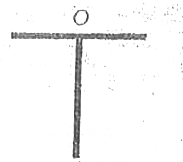Particle of masses m,2m,3m,…,nm grams are placed on the same line at distance l,2l,3l,…..,nlcm from a fixed point. The distance of centre of mass of the particles from the fixed point in centimeters is :
(2n+1)L4
L(2n+1)
n(n2+1)L2
(2n+1)L3
The correct Answer is:D
To find the distance of the center of mass of particles with masses m,2m,3m,…,nm placed at distances l,2l,3l,…,nl from a fixed point, we can follow these steps:
1. Identify the masses and their positions:
- The masses are m1=m,m2=2m,m3=3m,…,mn=nm.
- The corresponding positions are r1=l,r2=2l,r3=3l,…,rn=nl.
2. Use the formula for the center of mass (COM):
xcm=m1r1+m2r2+m3r3+…+mnrnm1+m2+m3+…+mn
3. Calculate the numerator:
Numerator=m⋅l+2m⋅2l+3m⋅3l+…+nm⋅nl
This can be simplified as:
=ml+4ml+9ml+…+n2ml=ml(12+22+32+…+n2)
4. Use the formula for the sum of squares:
The sum of the squares of the first n natural numbers is given by:
n∑k=1k2=n(n+1)(2n+1)6
Therefore, the numerator becomes:
=ml⋅n(n+1)(2n+1)6
5. Calculate the denominator:
Denominator=m+2m+3m+…+nm=m(1+2+3+…+n)=m⋅n(n+1)2
(using the formula for the sum of the first n natural numbers).
6. Substituting the numerator and denominator into the COM formula:
xcm=ml⋅n(n+1)(2n+1)6m⋅n(n+1)2
7. Cancel out common terms:
The m and n(n+1) terms cancel out:
xcm=l⋅2n+1612=l(2n+1)3
Final Answer:
Thus, the distance of the center of mass from the fixed point is:
l(2n+1)3
- The masses are m1=m,m2=2m,m3=3m,…,mn=nm.
- The corresponding positions are r1=l,r2=2l,r3=3l,…,rn=nl.
xcm=m1r1+m2r2+m3r3+…+mnrnm1+m2+m3+…+mn
Numerator=m⋅l+2m⋅2l+3m⋅3l+…+nm⋅nl
This can be simplified as:
=ml+4ml+9ml+…+n2ml=ml(12+22+32+…+n2)
The sum of the squares of the first n natural numbers is given by:
n∑k=1k2=n(n+1)(2n+1)6
Therefore, the numerator becomes:
=ml⋅n(n+1)(2n+1)6
Denominator=m+2m+3m+…+nm=m(1+2+3+…+n)=m⋅n(n+1)2
(using the formula for the sum of the first n natural numbers).
xcm=ml⋅n(n+1)(2n+1)6m⋅n(n+1)2
The m and n(n+1) terms cancel out:
xcm=l⋅2n+1612=l(2n+1)3
Thus, the distance of the center of mass from the fixed point is:
l(2n+1)3
Similar Questions
The locus of a point at a distance 3 cm from a fixed point.
View SolutionThe locus of points at a distance 2 cm from a fixed line.
View SolutionA particle of mass 100 gm and charge 2μC is released from a distance of 50 cm from a fixed charge of 5μC. Find the speed of the particle when its distance from the fixed charge becomes 3 m.
View SolutionWhen .n. number of particles of masses m, 2m, 3m, …….. nm are at distances x1=1,x2=2,x3=3,……………xn=n units respectively from origin on the x-axis, then find the distance of centre of mass of the system from origin.
View SolutionTwo uniform thin rods each of length L and mass m are joined as shown in the figure. Find the distance of centre of mass the system from point O
 View Solution
View SolutionFour particles having masses, m, 2m, 3m, and 4m are placed at the four corners of a square of edge a. Find the gravitational force acting on a particle of mass m placed at the centre.
View SolutionFour particles having masses, m, 2m, 3m, and 4m are placed at the four corners of a square of edge a. Find the gravitational force acting on a particle of mass m placed at the centre.
View SolutionTwo particles of masses m and 2m are placed at separation L. Find the M.I. about an axis passing through the center of mass and perpendicular to the line joining the point masses.
View SolutionWhen n number of particles of masses m,2m,3m,……..nm are at distances x1=1,x2=4,x3=9,………xn=n2 units respectively from origin on the x-axis, then find the distance of their centre of mass from origin.
View SolutionA particle of mass 2 g and charge 1μC is held at rest on a frictionless surface at a distance of 1m from a fixed charge of 1 mC. If the particle is released it will be repelled. The speed of the particle when it is at distance of 10 m from fixed charge is :
View Solution

